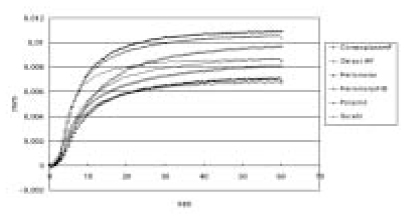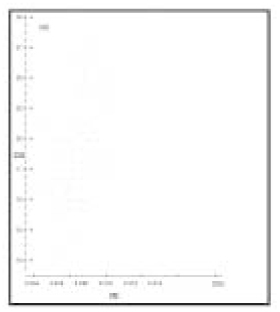J Korean Acad Conserv Dent.
2005 Nov;30(6):442-449. 10.5395/JKACD.2005.30.6.442.
Correlation between Linear polymerization shrinkage & tooth cuspal deflection
- Affiliations
-
- 1Department of Conservative Dentistry, College of Dentistry, Yonsei University, Korea. sunghopark@yumc.yonsei.ac.kr
- 2Department of Oral Science Research Center & Brain Korea 21 Project for Medical Science, College of Dentistry, Yonsei University, Korea.
- KMID: 2175747
- DOI: http://doi.org/10.5395/JKACD.2005.30.6.442
Abstract
- The purpose of the present study was to evaluate the relationship between the amount of cuspal deflection and linear polymerization shrinkage in resin composite and polyacid modified resin composite. For cuspal defelction and shrinkage measurement, Dyract AP, Compoglass F, Z100, Surefil, Pyramid, Synergy Compact, Heliomolar and Heliomolar HB were used. For measuring polymerization shrinkage, a custom made linometer (R&B, Daejon, Korea) was used. The amount of shrinkage among materials was compared using One-way ANOVA analysis and Tukey's test at the 95% of confidence level. For measuring cuspal deflection of teeth, standardized MOD cavities were prepared in extracted maxillary premolars. After a self-etching adhesive was applied, cavities were bulk filled with one of the filling materials.Fifteen teeth were used for each material. Cuspal deflection was measured by a custom made cuspal-deflection measuring device. One-way ANOVA analysis and Tukey's test were used to determine differences between the materials at the 95% of confidence level. Correlation of polymerization shrinkage and cuspal deflection were analyzed by regression analysis. The amount of polymerization shrinkage from least to greatest was Heliomolar, Surefil < Heliomolar HB < Z100, Synergy Compact < Dyract AP < Pyramid, Compoglass F (p < 0.05). The amount of cuspal deflection from least to greatest was Z100, Heliomolar, Heliomolar HB, Synergy Compact Surefil < Compoglass F < Pyramid, Dyract AP (p < 0.05). The amount of polymerization shrinkage and cuspal deflection showed a correlation (p < 0.001).
Figure
Reference
-
1. Eick JD, Welch FH. Polymerization shrinkage of posterior composite resins and its possible influence on postoperative sensitivity. Quintessence Int. 1986. 17:103–111.2. Kemp-Scholte CM, Davidson CL. Marginal sealing of curing contraction gaps in class V composite resin restorations. J Dent Res. 1988. 67:841–845.
Article3. Söderholm KJ. Correlation of in vivo and in vitro performance of adhesive restorative materials: a report of the ASCDM156 Task Group on Test Methods for Adhesion of Restorative Materials. Dent Mater. 1991. 7:74–83.
Article4. Roberts JC, Powers JM, Craig RG. Fracture toughness of composite and unfilled restorative resins. J Dent Res. 1977. 56:748–753.
Article5. Hansen EK. Effect of cavity depth and application technique on marginal adaptation of resins in dentin cavities. J Dent Res. 1986. 65:1319–1321.
Article6. Krejci I, Sperr D, Lutz F. A three-sited light curing technique for conventional Class II composite restorations. Quintessence Int. 1987. 18:125–131.7. Feilzer AJ, De Gee AJ, Davidson CL. Setting stress in composite resin in relation to configuration of the restoration. J Dent Res. 1987. 66:1636–1639.
Article8. Ernst CP, Kurschner R, Rippin G, Willershausen B. Stress reduction in resin-based composites cured with a two-step light-curing unit. Am J Dent. 2000. 13:69–72.9. Causton BE, Miller B, Softon J. The deformation of cusps by bonded posterior composite restorations: an in vitro study. Brit Dent J. 1985. 159:397–400.
Article10. Pearson GJ, Hegarty SM. Cusp movement in molar teeth using dentine adhesives and composite filling materials. Biomaterials. 1987. 8:473–476.
Article11. Lutz F, Krejci I, Barbakow F. Quality and durability of marginal adaptation in bonded composite restorations. Dent Mater. 1991. 7:107–113.
Article12. Suliman AA, Boyers DB, Lakes RS. Cusp movement in premolars resulting from composite polymerization shrinkage. Dent Mater. 1993. 9:6–10.
Article13. Lee SY, Park SH. Measurements of shrinkage stress and reduction of inter-cuspal distance in maxillary premolars resulting from polymerization of composites and compomers. J Korean Acad Conserv Dent. 2004. 29:346–352.
Article14. Park SH, Lee SY, Cho YS, Kim SS. Amount of polymerization shrinkage stress in composites and compomers for posterior restoration. J Korean Acad Conserv Dent. 2003. 28:348–353.
Article15. Ferracane JL, Mitchem JC. Relationship between composite contraction stress and leakage in class V cavities. Am J Dent. 2003. 16:239–243.16. Park SH, Krejci I, Lutz F. Consistency in the amount of linear polymerization shrinkage in syringe-type composites. Dent Mater. 1999. 15:442–446.
Article17. Park SH, Krejci I, Lutz F. Microhardness of resin composites polymerized by plasma arc or conventional visible light curing. Oper Dent. 2002. 27:30–37.18. Abbas G, Fleming GJP, Harrington E, Shortall ACC, Burke FJT. Cuspal movement and microleakage in premolar teeth restored with a packable composite cured in bulk or in increments. J Dent. 2003. 31:437–444.
Article19. Lim BS, Ferracane JL, Sakaguchi RL, Condon JR. Reduction of polymerization contraction stress for dental composites by two-step light activation. Dent Mater. 2002. 18:436–444.
Article20. Christensen GJ. Tooth colored posterior restoration. Oper Dent. 1997. 22:146–148.21. Chung JH, Roh BD. In vitro microshear bond strength of five composite resins to dentin with five different dentin adhesives. J Korean Acad Conserv Dent. 2004. 29:353–364.
Article
- Full Text Links
- Actions
-
Cited
- CITED
-
- Close
- Share
- Similar articles
-
- Effect of intermittent polymerization on the rate of polymerization shrinkage and cuspal deflection in composite resin
- Measurements of shrinkage stress and reduction of inter-cuspal distance in maxillary premolars resulting from polymerization of composites and compomers
- Cuspal deflection in class V cavities restored with composite resins
- A new method to measure the linear polymerization shrinkage of composites using a particle tracking method with computer vision
- The effect of viscosity, specimen geometry and adhesion on the linear polymerization shrinkage measurement of light cured composites







